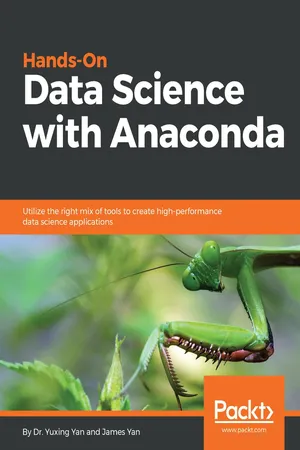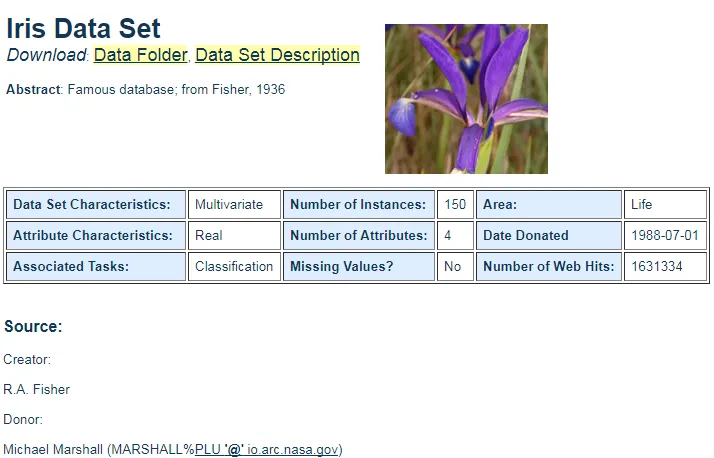
Hands-On Data Science with Anaconda
Utilize the right mix of tools to create high-performance data science applications
- 364 pages
- English
- ePUB (mobile friendly)
- Available on iOS & Android
Hands-On Data Science with Anaconda
Utilize the right mix of tools to create high-performance data science applications
About This Book
Develop, deploy, and streamline your data science projects with the most popular end-to-end platform, AnacondaAbout This Book• Use Anaconda to find solutions for clustering, classification, and linear regression• Analyze your data efficiently with the most powerful data science stack• Use the Anaconda cloud to store, share, and discover projects and librariesWho This Book Is ForHands-On Data Science with Anaconda is for you if you are a developer who is looking for the best tools in the market to perform data science. It's also ideal for data analysts and data science professionals who want to improve the efficiency of their data science applications by using the best libraries in multiple languages. Basic programming knowledge with R or Python and introductory knowledge of linear algebra is expected.What You Will Learn• Perform cleaning, sorting, classification, clustering, regression, and dataset modeling using Anaconda• Use the package manager conda and discover, install, and use functionally efficient and scalable packages• Get comfortable with heterogeneous data exploration using multiple languages within a project• Perform distributed computing and use Anaconda Accelerate to optimize computational powers• Discover and share packages, notebooks, and environments, and use shared project drives on Anaconda Cloud• Tackle advanced data prediction problemsIn DetailAnaconda is an open source platform that brings together the best tools for data science professionals with more than 100 popular packages supporting Python, Scala, and R languages. Hands-On Data Science with Anaconda gets you started with Anaconda and demonstrates how you can use it to perform data science operations in the real world.The book begins with setting up the environment for Anaconda platform in order to make it accessible for tools and frameworks such as Jupyter, pandas, matplotlib, Python, R, Julia, and more. You'll walk through package manager Conda, through which you can automatically manage all packages including cross-language dependencies, and work across Linux, macOS, and Windows. You'll explore all the essentials of data science and linear algebra to perform data science tasks using packages such as SciPy, contrastive, scikit-learn, Rattle, and Rmixmod.Once you're accustomed to all this, you'll start with operations in data science such as cleaning, sorting, and data classification. You'll move on to learning how to perform tasks such as clustering, regression, prediction, and building machine learning models and optimizing them. In addition to this, you'll learn how to visualize data using the packages available for Julia, Python, and R.Style and approachThis book is your step-by-step guide full of use cases, examples and illustrations to get you well-versed with the concepts of Anaconda.
Frequently asked questions
Information
Data Basics
- Sources of data
- Introduction to the Python pandas package
- Several ways to inputting packages
- Introduction to the Quandl data delivery platform
- Dealing with missing data
- Sorting data, as well as how to slice, dice, and merge various datasets
- Introduction to Python packages: cbsodata and datadotword
- Introduction to R packages: dslabs, haven, and foreign
- Generating Python datasets
- Generating R datasets
Sources of data
UCI machine learning


| Name | Web page | Data types |
| UCI | http://archive.ics.uci.edu/ml/index.php | Data for machine learning |
| World Health Organization | http://www.who.int/en/ | Healthcare data |
| Amazon Web Services | https://aws.amazon.com/cn/datasets/?nc1=h_ls | Web usage |
| Data.gov (US Government Open Data) | https://www.data.gov/ | Agriculture, climate, consumer, and so on |
| GitHub | https://github.com/caesar0301/awesome-public-datasets | Many datasets offered by individuals |
| Open data network | https://www.opendatanetwork.com/ | Many useful datasets |
| Government health data | https://www.healthdata.gov/ | Healthcare-related datasets |
| Google public data | https://www.google.com/publicdata/directory | World development indicators |
Table of contents
- Title Page
- Copyright and Credits
- Dedication
- Packt Upsell
- Contributors
- Preface
- Ecosystem of Anaconda
- Anaconda Installation
- Data Basics
- Data Visualization
- Statistical Modeling in Anaconda
- Managing Packages
- Optimization in Anaconda
- Unsupervised Learning in Anaconda
- Supervised Learning in Anaconda
- Predictive Data Analytics – Modeling and Validation
- Anaconda Cloud
- Distributed Computing, Parallel Computing, and HPCC
- References
- Other Books You May Enjoy